
Ever wondered why your treadmill workouts feel stiff and uncomfortable? It could be because you’re skipping crucial stretches before treadmill sessions. Proper stretching boosts blood flow, improves flexibility, and helps prevent injuries.
Dr. Elizabeth Gardner [¹], an orthopaedic sports medicine surgeon, from Yale Medicine supports the importance of warming up your muscles before jumping into activities like running on a treadmill.
Sitting for long periods can cause your muscles to tighten up, and if you start running without proper preparation, you’re more likely to get injured. A good stretch before exercise helps your muscles adjust and handle the strain, making your workout safer and more effective.
CLICK HERE to watch the YouTube video.
1. Quad Stretch
For this exercise, you may utilize a wall, a chair, or a countertop for support.
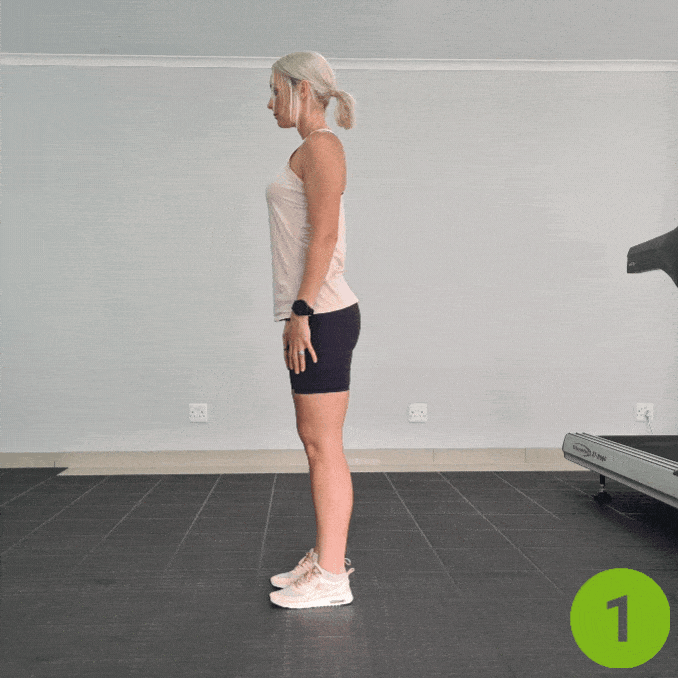
Quad Stretch
- Begin in an upright standing position with your feet hip-width apart, while maintaining good alignment with your head, shoulders, hips, and legs.
- Bring your left heel up against your seat, holding your foot with your left hand.
- Hold the position for a few seconds.
- Relax and then return to the starting position.
- Repeat the movement on the opposite side.
2. Hamstring Stretch
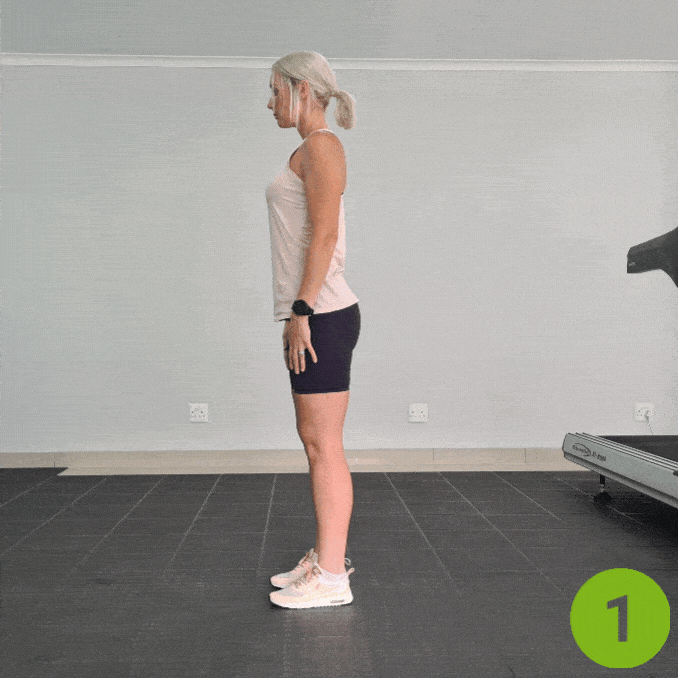
Hamstring Stretch
- Begin in an upright standing position with your feet hip-width apart, maintaining good alignment with your head, shoulders, hips, and legs.
- Take one step forward with your left leg, heel press on the floor and toes pointing upward.
- Engage your core and slightly bend your right knee as you reach your hands towards your left foot while keeping your spine straight.
- Hold the position for several deep belly breaths, in through your nose and then out through your mouth.
- Relax to return to the starting position and then repeat the movement on the opposite side.
Laura Decoster [²], a certified athletic trainer, along with a physical therapist and PhD expert, emphasized that hamstring stretching helps improve flexibility, no matter what technique, position, or how long you stretch.
3. Hip Rotations
For this exercise, you may utilize a wall, a chair, or a countertop for support.
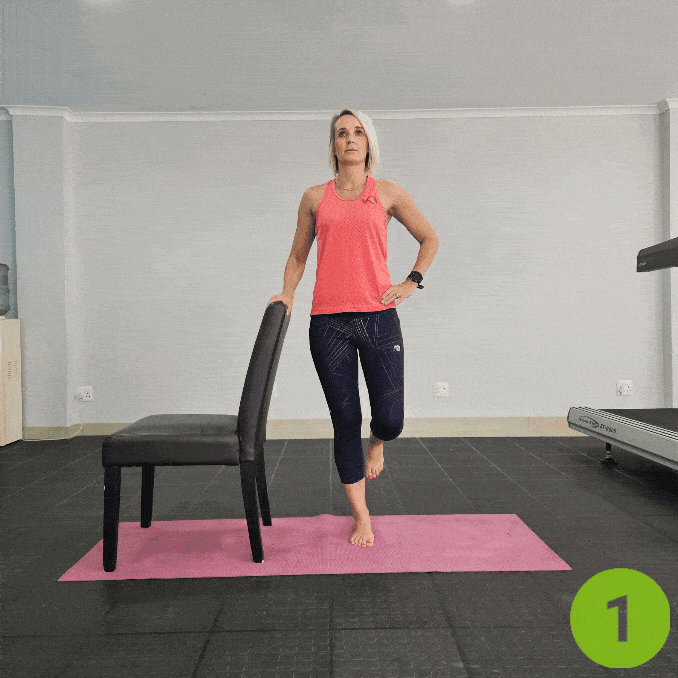
Hip Rotations
- Begin in an upright standing position beside a chair with your feet hip-width apart, while maintaining good alignment with your head, shoulders, hips, and legs.
- Place one hand on the back of the chair for support while the opposite hand is on your hip.
- Engage your core and lift one knee up at a hip level, then open your knee out to the side, ideally in line with your hips.
- Bring it back to the center and repeat the sequence of movement for 3 to 5 repetitions. Lower your leg down and then repeat the movement on the opposite side.
4. Calf Stretch
For this exercise, you may utilize stairs, a yoga block, or anything on which you can place your foot in an incline position.
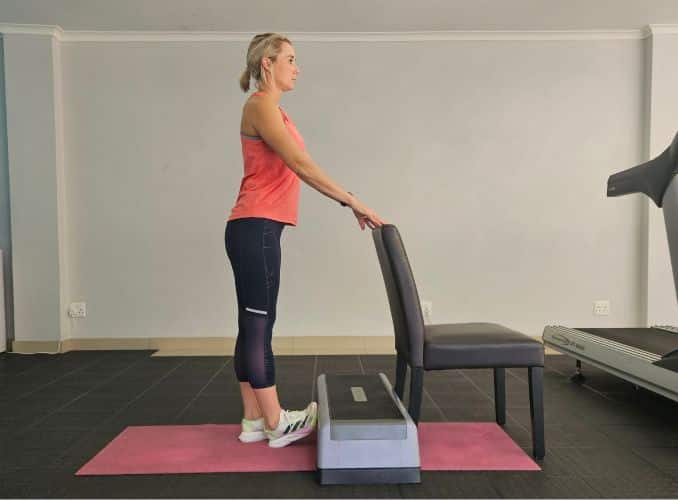
Calf Stretch
- Begin in an upright standing position with your feet hip-width apart, while maintaining good alignment with your head, shoulders, hips, and legs.
- Engage your core.
- Take a step forward and place one foot against a yoga block in an incline position as you look for a light stretch on the calf area.
- Hold the position for a couple of seconds then relax to return to the starting position and repeat the movement on the opposite side.
James Youdas [³], a Physical Therapist, suggests that static stretching of the calf muscles is a beneficial practice for maintaining flexibility. Incorporating longer or varied stretching techniques could further enhance results and improve mobility.
Why Stretch Before Using a Treadmill?
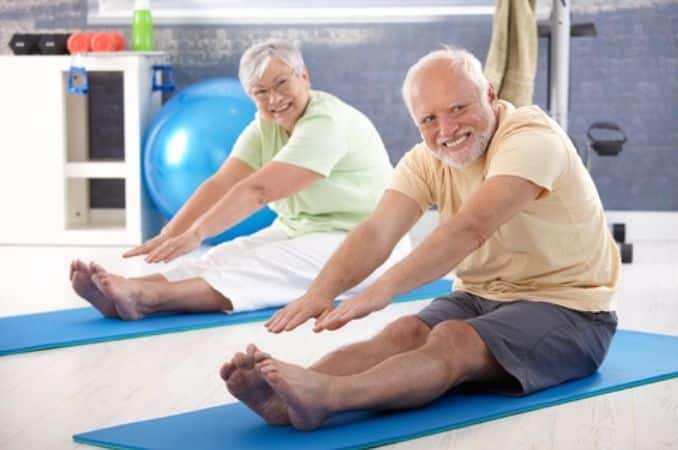
A 2002 study [⁴] shows that stretching increases the range of motion in your joints, helping you move more freely and comfortably. This increased flexibility helps you run or walk with a greater stride length and smoother motion, enhancing your treadmill performance.
Differences Between Dynamic and Static Stretching
Dynamic stretching [5] involves moving parts of your body and gradually increasing reach, speed of movement, or both. It is typically performed through exercises like leg swings, arm circles, or walking lunges.
Static stretching [6], on the other hand, involves holding a stretch in a challenging but comfortable position for a period of time, typically 15-60 seconds. This type of stretching is designed to lengthen muscles and improve flexibility.
Impact on Injury Prevention and Muscle Activation
According to a 2012 study [7], stretching activates and engages your muscles. It’s often done before exercise to improve performance and lower the risk of injury. Proper stretching before your treadmill workout warms up your muscles and prepares them for activity, reducing the risk of injuries like strains and also sprains.
Recommended Duration for Warming Up and Stretching
Before starting your treadmill workout, it’s essential to include stretches before treadmill use, aiming for a 5 to 10-minute warm-up. Incorporate dynamic stretches like leg swings or walking lunges, performing each for 20 to 30 seconds per side, to boost blood flow and also improve muscle flexibility.
Benefits of Stretching
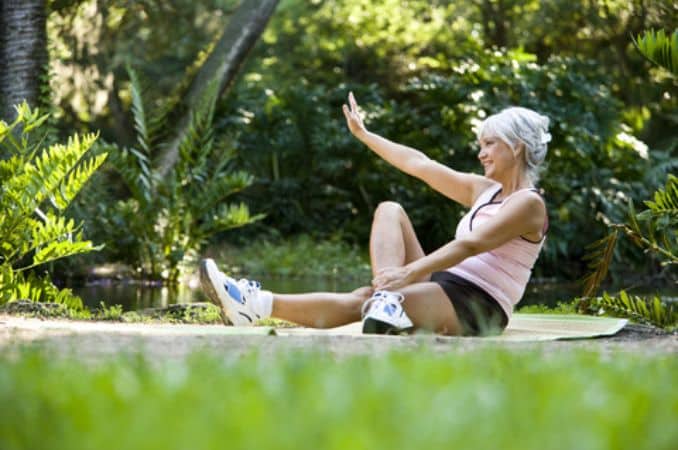
- Increases Flexibility: Regular stretching improves the range of motion in your joints and muscles, making it easier to perform various physical activities.
- Enhances Blood Flow: Stretching boosts circulation, which helps deliver more oxygen and nutrients to your muscles, aiding in overall muscle health and recovery.
- Reduces Muscle Stiffness: Stretching also helps to alleviate muscle tightness and stiffness, making movement smoother and reducing discomfort.
- Prevents Injuries: Proper stretching prepares your muscles and joints for exercise, reducing the risk of strains, sprains, and other injuries.
- Improves Posture: By stretching tight muscles, you can help correct imbalances and promote better alignment, which improves overall posture.
- Boosts Performance: Increased flexibility and muscle readiness contribute to better performance in physical activities by allowing for more efficient and effective movements.
- Relieves Stress: Stretching can also help relax your body and mind, reducing stress and promoting a sense of well-being.
Aids in Muscle Recovery: Stretching after exercise helps to relax muscles, prevent soreness, and accelerate recovery.
Risks of Skipping Treadmill Stretches
- Muscle stiffness and reduced flexibility
- Increased risk of strains and sprains
- Discomfort during exercise
- Lower workout performance and effectiveness
Conclusion
Stretches before treadmill workouts are essential to improve muscle flexibility, enhance blood flow, and reduce injury risk. Doing stretches like quad stretches, hamstring stretches, hip rotations, and calf stretches can help you perform better and feel more comfortable during your workout. These stretches also prep your muscles and joints for physical activity, potentially preventing injuries. Add these stretches to your warm-up routine to enjoy your treadmill sessions and avoid injuries.
For more great stretches to decrease pain and tightness, make sure to check out 11 Daily Stretches to Feel and Look Amazing, here!
Frequently Asked Questions:
What stretches should you do before a treadmill?
Focus on dynamic stretches for your lower body, including leg swings, walking lunges, and gentle knee lifts. These help warm up your muscles without overstretching cold tissues. Dynamic stretching [⁷] helps increase flexibility and range of motion, especially in joints like the hips, which is crucial for effective running.
How do you warm up before a treadmill run?
Start with 5-10 minutes of light walking on the treadmill, gradually increasing your speed. This raises your heart rate and also prepares your body for more intense exercise. A short [⁸], specific warm-up (like walking) is enough to prepare for running and can be more time-efficient, without sacrificing performance or increasing the risk of injury.
What to do before getting on a treadmill?
Ensure you’re properly hydrated, wearing appropriate footwear, and have adjusted the treadmill settings. Set any entertainment (music, podcasts) you plan to use during your workout. Additionally, perform a quick warm-up, such as light stretching or walking, to prepare your muscles and joints for the workout ahead.
Should I workout before the treadmill?
Should I workout before the treadmillIf you’re doing both cardio and strength training, it’s usually better to save running after your strength exercises. If you’re doing both cardio and strength training, it’s usually better to save running after your strength exercises.

